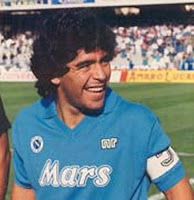‘Again?’ My football fanatic buddy quipped, exchanging
puzzled looks with me upon receiving the news of Diego Maradona’s second ban
from international football. The headline of the tabloid plainly put, ‘The
Genius Banned AGAIN’. His response I was to find out later on, mirrored the general
reaction that greeted this news item.
For many born beyond the years of this player’s reign,
Maradona would hold only a word-of-mouth and perhaps, passing value and mean
nothing much more. The privileged few who observed his rise from the streets of
Buenos Aires to the greens of Estadio Azteca – the venue of the Mexico ’86 World
Cup final would undoubtedly pen something unusual to this man. On the field of play,
you had an exact legend; sharp, fast, clever and tactical. Maradona infused
urgency, style and leadership to his games that brought opponents to awe and submission
and propelled his teams to vital victories and accolades. So profound was his influence
that the name ‘maradona’ unofficially came to mean cleverness, cunning and dexterity.
In fact, so widespread was this phenomenon that a former Nigerian military head
of state was dubbed such in response his double-faced and overly punitive leadership.
To come to terms with this disheartening information seemed surreal to we
staunch football loyalists all over the entire world.
‘Diego’ as he is fondly called was diagnosed positive to a
dope test that earned him a fifteen month ban on 17th March, 1991.
His return a year and seven months later was marred by a second ban received a
year and a half afterwards. His, marked the most popular case of drug abuse in
professional football. Many attribute drug use or rather, abuse to inflated
egos, pride and megalomania of victims - who often are famous people that reach
a certain level of stardom before ‘the fame starts to get to their heads’. The reasons
for these still remain unclear to many psychologists today.
One thesis however, pins euphoric states of walking on the red carpet , or more simply put; ‘the arrogant feelings of being chased by pressmen’ as being sustained by these harmful drugs especially when limousines, flashing lights, cameras, journalists, held-out mics, red carpets and ecstatic fans cannot always be around a star. What many of these famous people try to do is to artificially replicate these feelings by the use of abusive drugs which popularly include; heroin, cocaine and morphine.
In this case, Recreational
Drug Abuse is the descriptive term used.
Alternatively, in an attempt stay relevant and probably ‘legendary’,
some celebrities use medications to enhance their individual outputs or
stimulate their performances in their chosen fields. Popular track and field
athlete Marion Jones is a classic case.
Doping is a term
used to describe this phenomenon. Doping
tests are used to detect this.
Diego Maradona failed a doping test because cocaine was
found to be present in his blood stream. More popularly, he failed a second which
indicated high levels of Ephedrine – a known stimulant, performance enhancer
and banned substance by FIFA. Reports confirm he failed a third, cocaine being
the reason. A thorough look into the life of this man reveals tales of law
enforcement bust-ups, personal drug addictions, professional struggles and failing
credibility in the public eye. So protracted was this habit that a contract clause of his with a
football club required him to be tested before every game!
His undoubted influence on the game earned him a FIFA Player
of the Century Award – the direct consequence of a world-wide poll conducted amongst
various football supporters.
Maradona today, has since overcome these challenges and stated on
Argentine television that he had quit drinking and drug use.



No comments:
Post a Comment
Your thoughts are...